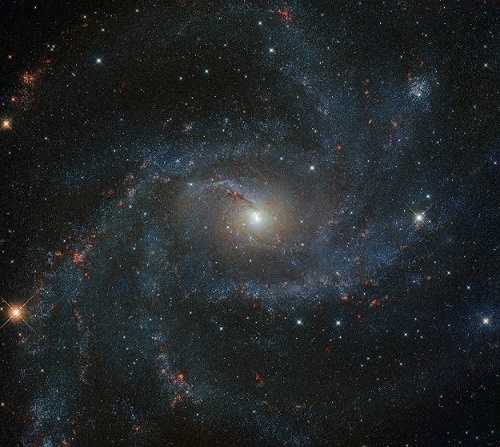NASA recently released the spectacular bright image of the firework galaxy NGC 6946 taken earlier by Hubble nafasi darubini (1)
A galaxy ni mfumo wa stars, remnants of stars, interstellar gas, dust, and dark matter that are bound together by gravitational force. According to an estimate, there are about 200 billion galaxies in the observable ulimwengu (2). The solar system along with the sun is part of the galaxy called Milky Way which is our home galaxy.
6946 (NGC inasimamia New General Catalogue ambayo ni njia ya kawaida ya kuweka lebo kwa vitu vya anga) ni mojawapo ya galaksi zilizo katika umbali wa 7.72 Mpc {1 Mpc au Megaparsecs sawa na paseki milioni; katika astronomia, kitengo cha umbali kinachopendekezwa ni parsec (pc). Sehemu 1 ni umbali ambao Kitengo 1 cha Astronomia hupunguza pembe ya sekunde 1 ya arc yaani 1/3600 ya digrii; pc 1 ni sawa na miaka mwanga 3.26} au miaka nuru milioni 25.2 katika kundinyota la Cepheus.
The galaxy, NGC 6946 ina kiwango cha juu cha kipekee cha uundaji wa nyota hivyo kuainishwa kama a starburst galaxy. Aina hii ya galaksi ina sifa ya viwango vya juu vya uundaji wa nyota katika mpangilio wa 10 - 100 M.☉/mwaka ambao ni wa juu zaidi kuliko galaksi za kawaida, kwa mfano katika galaksi yetu ya nyumbani ya Milky Way, kasi ya uundaji wa nyota ni takriban 1 - 5 M.☉/ mwaka (3) (M☉ ni misa ya jua, kitengo cha kawaida cha misa katika unajimu, 1 M☉ ni sawa na takriban 2×1030 kilo.).
On our time scale, stars appear to be unchanging but on the time scale of billions of years, stars undergo a life course, they are born, age and finally die. The life of a star begins in a nebula (cloud of dust, hydrogen, helium and other ionized gases) when the gravitational collapse of a giant cloud give rise to a protostar. This continues to grow further with accretion of gas and dust until it reaches its final mass. The final mass of the star determines its life time (lesser the mass, higher the life span) as well as what happens to the star during its life.
Vyote stars derive their energy from nuclear fusion. The nuclear fuel burning in the core creates strong outward pressure due to the high core temperature.This balances out the inward gravitational force. The balance is disturbed when the fuel in the core runs out. Temperature drops, outward pressure diminishes. As a result, the gravitational force of the inward squeeze becomes dominant forcing the core to contract and collapse. What a star finally ends up as after collapse depends on the mass of the star.
In the case of supermassive stars, When the core collapses in a short span of time, it creates enormous shock waves. The powerful and luminous explosion is called supernova. This transient astronomical event occurs during the last evolutionary stage of a supermassive star. The galaxy NGC 6946 is called the Fataki Galaxy kwa sababu ina uzoefu 10 aliona supernova katika karne iliyopita pekee. Kwa kulinganisha, Milky Way wastani wa supernovae moja hadi mbili kwa karne. Kwa hivyo, idadi nzuri ya mabaki ya supernova inatarajiwa katika galaksi ya NGC 6946. Jumla ya watahiniwa wa masalia ya supernova waliotambuliwa katika NGC 6946 ni takriban 225 (4,5). For stars more than 10 times the mass of the sun, the remnants would be mashimo meusi, the densest objects in the ulimwengu.
The high star-formation rate (starburst), the high rate of supernova events (fireworks) features, spiral structure and it being positioned face-on with us sets this galaxy apart giving rise to its spectacular appearance in the images taken by the Hubble darubini.
***
Vyanzo
- NASA 2021. Hubble Anatazama 'Fireworks Galaxy' ya Kuvutia. Ilichapishwa tarehe 08 Januari 2021. Inapatikana mtandaoni kwa https://www.nasa.gov/image-feature/goddard/2021/hubble-views-a-dazzling-fireworks-galaxy/ Ilifikiwa tarehe 10 Januari 2021.
- NASA 2015. Hubble Inafichua Ulimwengu Unaoonekana Una Magalaksi Mara 10 Zaidi ya Ilivyofikiriwa Awali. Inapatikana mtandaoni kwa https://www.nasa.gov/feature/goddard/2016/hubble-reveals-observable-universe-contains-10-times-more-galaxies-than-previously-thought Ilifikiwa tarehe 10 Januari 2021.
- Muxlow TWB., 2020. Starburst Galaxy. Kongamano la 8 la Mtandao wa VLBI wa Ulaya, Polandi 26-29 Septemba 2020. Inapatikana mnamo https://arxiv.org/ftp/astro-ph/papers/0611/0611951.pdf Ilifikiwa tarehe 10 Januari 2021.
- Long KS, Blair WP, et al 2020. Idadi ya Mabaki ya Supernova ya NGC 6946 Kama Inavyozingatiwa katika [Fe ii] 1.644 μm kwa HST*. Jarida la Astrophysical, Juzuu 899, Nambari 1. DOI: https://doi.org/10.3847/1538-4357/aba2e9
- Radica MC, Welch DL, na Rousseau-Nepton L., 2020. Utafutaji wa mwanga wa supernova unasikika katika NGC 6946 na SITELLE. Notisi za Kila Mwezi za Jumuiya ya Kifalme ya Astronomical, Juzuu 497, Toleo la 3, Septemba 2020, Kurasa 3297–3305, DOI: https://doi.org/10.1093/mnras/staa2006
***






































